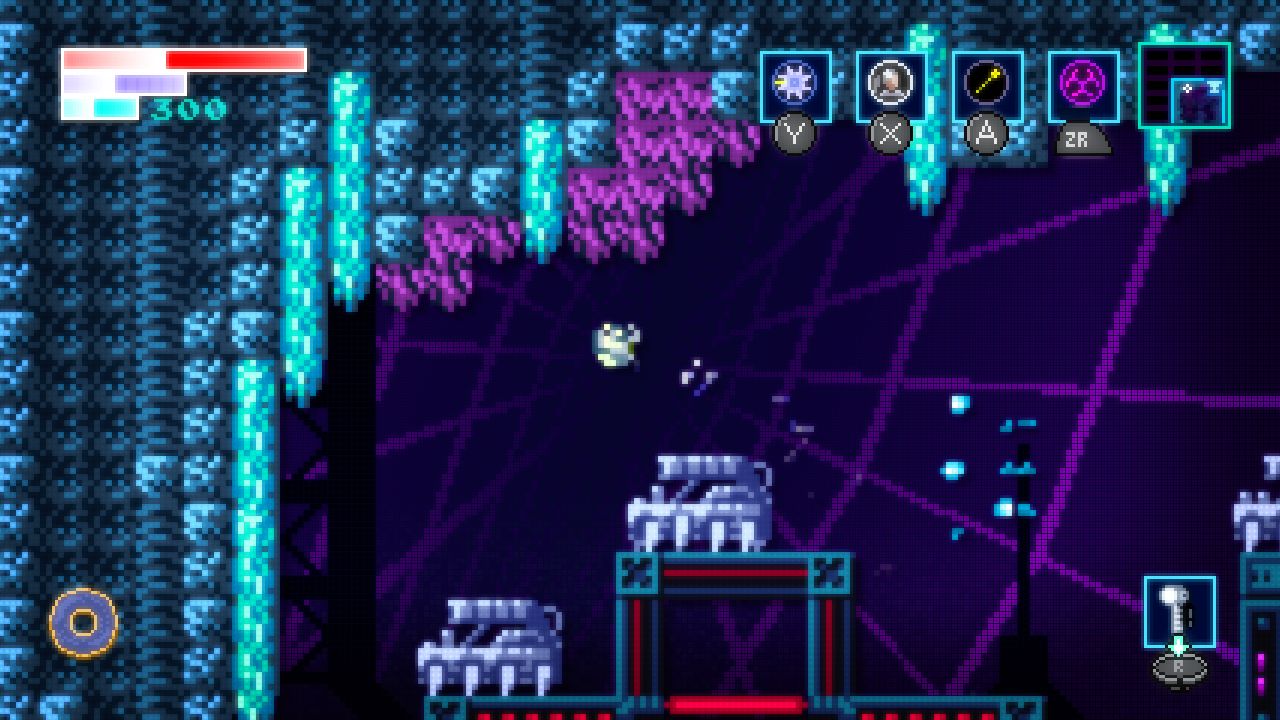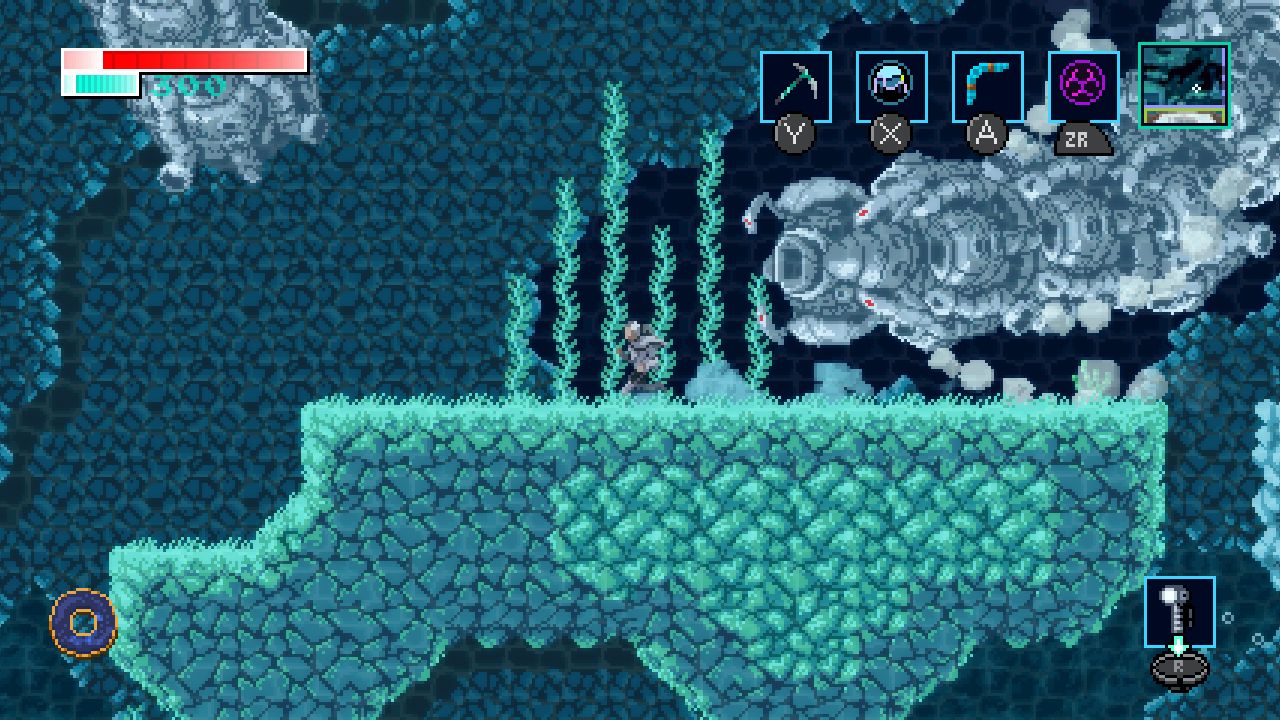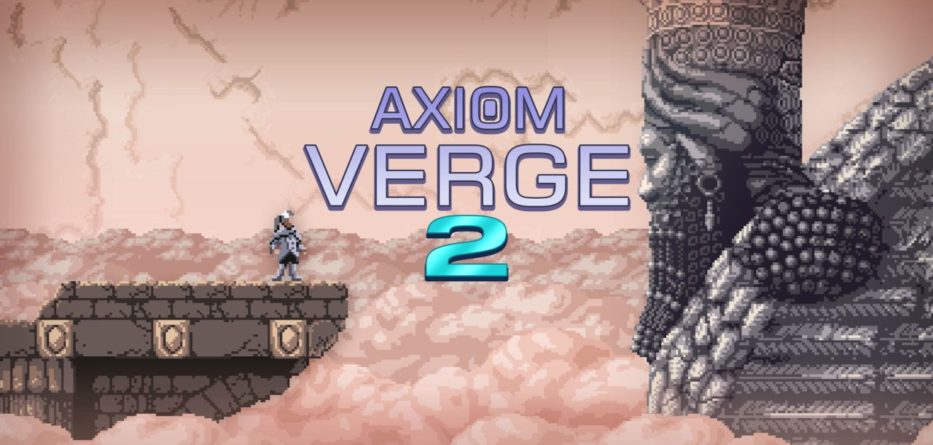What is immediately noticeable about Axiom Verge 2 is that it breaks from the traditional Metroidvania mould by…actually having colour. Instead of the dark, brooding, claustrophobic settings often associated with the genre (and the first Axiom Verge for that matter), Axiom Verge 2 takes place in an open-air alternate Earth. The game begins in Antarctica with piercing white snow-caps of the icy tundra and expands to other colourful biomes such as deserts and forests as you delve deeper into the game.
In this sense Axiom Verge 2 reminded me of Flashback; not just in its liberal use of colour but also in the fact that the game is about your player character, Indra Chaudhari, stumbling upon what at first appears to be an ancient civilisation but soon finding that they are an inexplicably advanced culture using children as bioweapons. To be honest, most of the story; told via small character interactions and collectible journals dispersed throughout the world; didn’t keep me engaged because, much like the first game, it was asphyxiated by convoluted lore, an overuse of proper nouns and technobabble that I’m not sure anyone outside of brilliant sole creator Thomas Happ’s cerebral cortex could properly understand or articulate. Despite a heartfelt endeavour to understand the connected Axiom Verge universe this time round, towards the end of the game I ended up skipping over a lot of the written dialogue as I was lost from the beginning.
From what I could gauge from the plot, other than the presence of a Matrix-esque Breach World you can access from different parts of the map, is that the alternate-Earth setting takes some inspiration from Sumerian/Mesopotamian history and culture. And the game is better for it since these influences are at their most stark in the soundtrack, which is utterly fantastic. The use of instrumentation that my untrained and uninformed ear can only describe as sitars and lyres coupled with otherworldly chanting layered on a nostalgic bed of 80s synthpop is an absurd amalgam that results in a tremendous soundtrack. It’s a world away from the chiptune-inspired beats of the first game and gels excellently with this fresher and brighter setting; bringing the world alive and making your journey through the ten-or-so-hour campaign that more enjoyable.
The gameplay of Axiom Verge 2 follows the typical structure of most Metroidvanias; explore an uninhabitable world and gradually accrue upgrades that allow you to traverse to new, previously gated areas. Where it differs is in the type of upgrades you get; they’re not as trite and predictable as a double jump and dash. Instead, the upgrades to your character’s arsenal and manoeuvrability are novel and each new one surprised and delighted me.

The novelty of the upgrades is at its most evident with a controllable drone companion you unlock early on into the game. Without delving into narrative spoilers, you actually end up embodying the drone for significant portions of the game. With responsive controls and a jump that neither feels too floaty nor too laboured, playing as Indra feels fluid and, initially, taking control of the drone feels sluggish in comparison. But when you start unlocking as many upgrades for your drone as Indra, which are both doled out at a satisfyingly brisk pace (not akin to something like Hollow Knight where you have about five hours between new abilities), the drone becomes a delight to control. The immensely satisfying feeling of becoming more agile, adept and comfortable in your surroundings is what underpins the majesty of the Metroidvania genre and Axiom Verge 2 accomplishes this sensation with aplomb.
From grappling hooks to hacking abilities there was nary an upgrade I could have predicted and finding out what the next one would be helped propel me through the game. There’s a late-game upgrade that seems to be included just to mop up any collectibles you missed along the way and is a great inclusion, supported by other quality of life improvements such as a detailed and coordinated world map, the ability to fast travel to the numerous save points at any time and the option to mark points of interest on the map.
Whilst the upgrades are genuinely different and interesting, it was disheartening that some only had a use in one or two scenarios. For example, late in the game I came across a remote control Batarang (not unlike that in the Arkham game series) and prematurely thought of all the interesting applications it could have only to find that the game ended shortly after with me only using it once. Whilst most of the upgrades have use in both combat and traversal scenarios and thus have double the practicality (sort of like every beam in Metroid), I seldom used them in combat encounters and this is because the combat in Axiom Verge 2 is the game’s biggest disappointment.

When it was revealed that boss fights would be optional in Axiom Verge 2 I was all on board. Metroidvanias often pride themselves on being difficult and boss fights can often be choke points that are unnecessary and frustrating barriers that inhibit players from experiencing the rest of the game (Zangetsu in Bloodstained Ritual of the Night or Death in any Castlevania game come to mind). So whilst I was in favour of the decision to make boss fights optional, in practice I truly believe it detracts from the game and saps almost all of the challenge from the game.
The bosses, which I struggled to identify as bosses other than the fact that they were bigger than the typical enemy fodder, were just floating or trudging around in the open world and can be skipped entirely without even acknowledging their presence. And if you do decide to approach them, it doesn’t result in a hard-won encounter since a few moderately well-timed swings of Indra’s pickaxe (her main melee weapon) will unceremoniously fell your quarry in a matter of seconds. Putting the bosses in an enclosed arena wouldn’t have made any difference since even the last boss could be worn down by attrition with the game providing you with infinite respawns in your bid to thwart them. After completing the game, I discovered that there are difficulty sliders in the menu but even so, the way Axiom Verge 2 approaches combat ventures too far in the opposite direction of most games of the genre and is almost devoid of challenge.
The shallowness of the combat extends largely to the enemies found scattered throughout the world. In the very early stages of the game a lot of the enemies can easily land a crushing blow if you’re not careful but as soon as you start accruing enough health and strength upgrades, dispatching foes becomes almost trivial. The health and strength upgrades are administered by finding canisters strewn throughout the world that are applied to a rudimentary skill tree, and there is no shortage of canisters so you’ll find yourself being overpowered against most enemies (except some late-game ones) almost immediately. It’s disappointing that the combat feels so undercooked and underwhelming, even for those who want a breezy experience, since engaging combat is an inextricable tenet of the Metroidvania genre and Axiom Verge 2 is completely bereft of it.
In closing, I’ll say this about Axiom Verge 2. Whilst the combat and story are underwhelming, the exploration and traversal of its unique world are where the game shines, especially when using your drone companion, which, frankly, stole the show. The upgrades to the characters are innovative and whilst the game never asks you to find many different applications for them, they are interesting to tinker with regardless. If you’re looking for a Metroidvania with a modest runtime that isn’t just “another one of those” and desire a laid-back experience accompanied by a soundtrack the likes of which you’ve never heard, then I’d recommend seeing what Axiom Verge 2 is all about.
Should you play it? Yes
Why… If you’re looking for a Metroidvania that strays from the traditional mould and has innovative mechanics, a unique setting and a psychedelic soundtrack then I can’t think of a better game.
But… Go in knowing that you’ll likely be confused by the over-involved story and underwhelmed by the shallow combat.
Reviewed on Nintendo Switch
Developer/Publisher: Thomas Happ/Thomas Happ Games LLC
Playable on: PC (Epic Games), PlayStation 4 and Nintendo Switch
Released: 11th August, 2021








